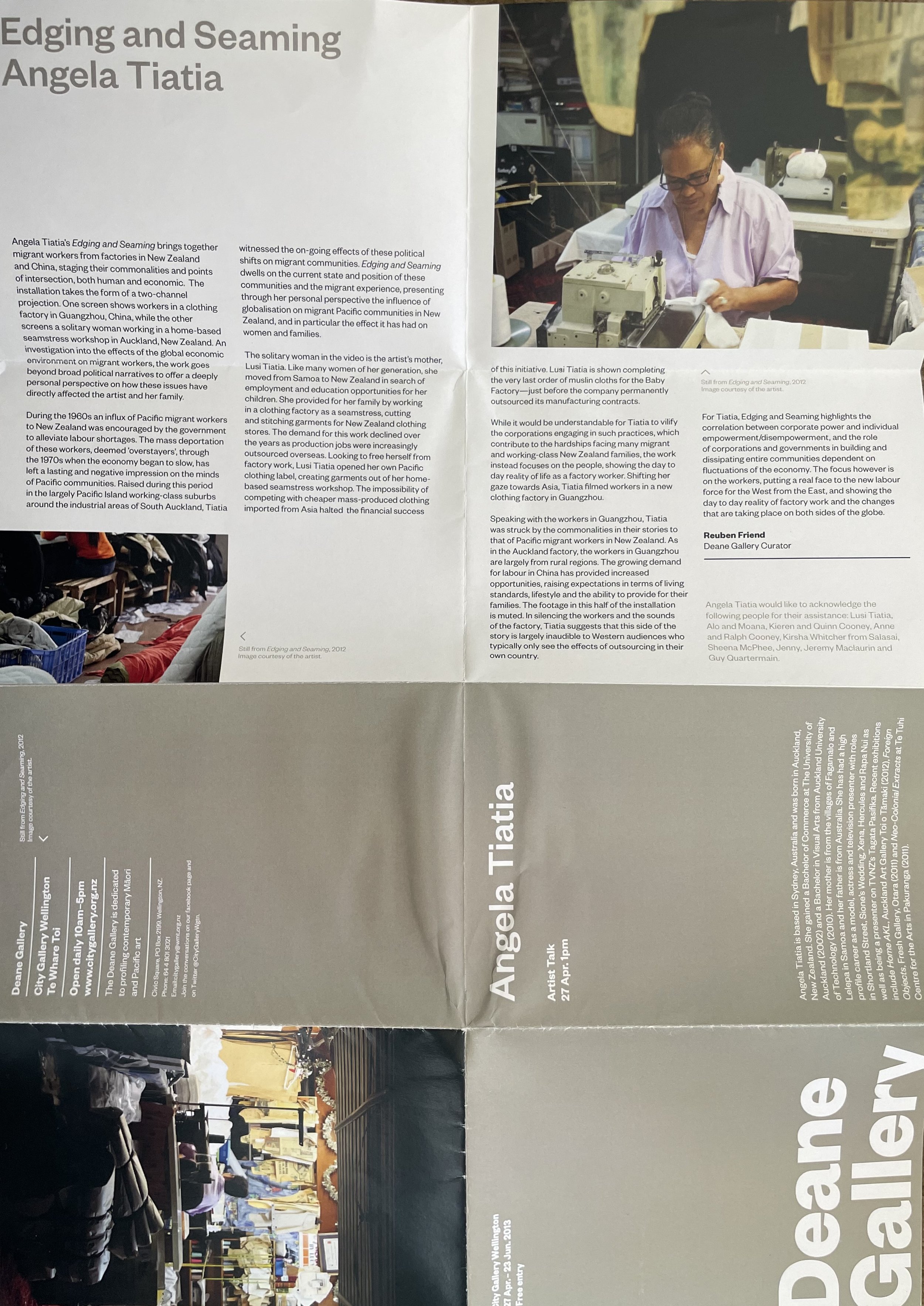Angela Tiatia: Edging and Seaming
City Gallery Wellington | Te Whare Toi
Deane Gallery, 27 April–23 June 2013
The invisible hand of the global economy has a massive impact on identity, but, in the end, workers are dispensable in the pursuit of profit. Angela Tiatia’s two-channel video Edging and Seaming connects New Zealand Pacific Island factory workers and Chinese ones. We see the artist’s mother, Lusi, completing her last garment-construction-work consignment for the Baby Factory, before they outsource to China. We also see the factory in Guangzhou, where the work is now done. Tiatia suggests commonality and difference between the two labour forces. The desire to provide for immediate and extended family is a strong aspect of both Pacific Island and Chinese mindsets.
The following essay is taken from the catalogue publication that was written to accompany the exhibition:
Angela Tiatia: Edging and Seaming
by Reuben Friend
Angela Tiatia's Edging and Seaming brings together migrant workers from factories in New Zealand and China, staging their commonalities and points of intersection, both human and economic. The installation takes the form of a two-channel projection. One screen shows workers in a clothing factory in Guangzhou, China, while the other screens a solitary woman working in a home-based seamstress workshop in Auckland, New Zealand. An investigation into the effects of the global economic environment on migrant workers, the work goes beyond broad political narratives to offer a deeply personal perspective on how these issues have directly affected the artist and her family.
During the 1960s an influx of Pacific migrant workers to New Zealand was encouraged by the government to alleviate labour shortages. The mass deportation of these workers, deemed 'overstayers', through the 1970s when the economy began to slow, has left a lasting and negative impression on the minds of Pacific communities. Raised during this period in the largely Pacific Island working-class suburbs around the industrial areas of South Auckland, Tiatia witnessed the on-going effects of these political shifts on migrant communities. Edging and Seaming dwells on the current state and position of these communities and the migrant experience, presenting through her personal perspective the influence of globalisation on migrant Pacific communities in New Zealand, and in particular the effect it has had on women and families.
The solitary woman in the video is the artist's mother, Lusi Tiatia. Like many women of her generation, she moved from Samoa to New Zealand in search of employment and education opportunities for her children. She provided for her family by working in a clothing factory as a seamstress, cutting and stitching garments for New Zealand clothing stores. The demand for this work declined over the years as production jobs were increasingly outsourced overseas. Looking to free herself from factory work, Lusi Tiatia opened her own Pacific clothing label, creating garments out of her home-based seamstress workshop. The impossibility of competing with cheaper mass-produced clothing imported from Asia halted the financial success of this initiative. Lusi Tiatia is shown completing the very last order of muslin cloths for the Baby Factory-just before the company permanently outsourced its manufacturing contracts.
While it would be understandable for Tiatia to vilify the corporations engaging in such practices, which contribute to the hardships facing many migrant and working-class New Zealand families, the work instead focuses on the people, showing the day to day reality of life as a factory worker. Shifting her gaze towards Asia, Tiatia filmed workers in a new clothing factory in Guangzhou.
Speaking with the workers in Guangzhou, Tiatia was struck by the commonalities in their stories to that of Pacific migrant workers in New Zealand. As in the Auckland factory, the workers in Guangzhou are largely from rural regions. The growing demand for labour in China has provided increased opportunities, raising expectations in terms of living standards, lifestyle and the ability to provide for their families. The footage in this half of the installation is muted. In silencing the workers and the sounds of the factory, Tiatia suggests that this side of the story is largely inaudible to Western audiences who typically only see the effects of outsourcing in their own country.
For Tiatia, Edging and Seaming highlights the correlation between corporate power and individual empowerment/disempowerment, and the role of corporations and governments in building and dissipating entire communities dependent on fluctuations of the economy. The focus however is on the workers, putting a real face to the new labour force for the West from the East, and showing the day to day reality of factory work and the changes that are taking place on both sides of the globe.
Angela Tiatia would like to acknowledge the following people for their assistance: Lusi Tiatia, Alo and Moana, Kieren and Quinn Cooney, Anne and Ralph Cooney, Kirsha Whitcher from Salasai, Sheena McPhee, Jenny, Jeremy Maclaurin and Guy Quartermain.
ARTIST BIOGRAPHY
Angela Tiatia is based in Sydney, Australia and was born in Auckland, New Zealand. She gained a Bachelor of Commerce at The University of Auckland (2002) and a Bachelor in Visual Arts from Auckland University of Technology (2010). Her mother is from the villages of Fagamalo and Lelepa in Samoa and her father is from Australia. She has had a high profile career as a model, actress and television presenter with roles in Shortland Street, Sione's Wedding, Xena, Hercules and Rapa Nui as well as being a presenter on TVNZ's Tagata Pasifika. Recent exhibitions include Home AKL, Auckland Art Gallery Toi o Tamaki (2012), Foreign Objects, Fresh Gallery, Otara (2011) and Neo-Colonial Extracts at Te Tuhi Centre for the Arts in Pakuranga (2011).










